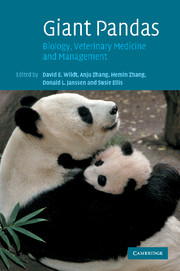Book contents
- Frontmatter
- Contents
- List of contributors
- Foreword
- Acknowledgements
- 1 The giant panda as a social, biological and conservation phenomenon
- 2 The Giant Panda Biomedical Survey: how it began and the value of people working together across cultures and disciplines
- 3 Factors limiting reproductive success in the giant panda as revealed by a Biomedical Survey
- 4 Significant medical issues and biological reference values for giant pandas from the Biomedical Survey
- 5 Life histories and behavioural traits as predictors of breeding status
- 6 Nutrition and dietary husbandry
- 7 Male reproductive biology in giant pandas in breeding programmes in China
- 8 Endocrinology of the giant panda and application of hormone technology to species management
- 9 The value and significance of vaginal cytology
- 10 Parentage assessment among captive giant pandas in China
- 11 The science of behavioural management: creating biologically relevant living environments in captivity
- 12 Evaluating stress and well-being in the giant panda: a system for monitoring
- 13 The neonatal giant panda: hand-rearing and medical management
- 14 Consequences of early rearing on socialization and social competence of the giant panda
- 15 Medical management of captive adult and geriatric giant pandas
- 16 Diseases and pathology of giant pandas
- 17 Ultrasonography to assess and enhance health and reproduction in the giant panda
- 18 Gastrointestinal endoscopy in the giant panda
- 19 Historical perspective of breeding giant pandas ex situ in China and high priorities for the future
- 20 Role and efficiency of artificial insemination and genome resource banking
- 21 Analysis of demographic and genetic trends for developing a captive breeding masterplan for the giant panda
- 22 Partnerships and capacity building for securing giant pandas ex situ and in situ: how zoos are contributing to conservation
- Index
- Plate Section
- References
12 - Evaluating stress and well-being in the giant panda: a system for monitoring
Published online by Cambridge University Press: 09 August 2009
- Frontmatter
- Contents
- List of contributors
- Foreword
- Acknowledgements
- 1 The giant panda as a social, biological and conservation phenomenon
- 2 The Giant Panda Biomedical Survey: how it began and the value of people working together across cultures and disciplines
- 3 Factors limiting reproductive success in the giant panda as revealed by a Biomedical Survey
- 4 Significant medical issues and biological reference values for giant pandas from the Biomedical Survey
- 5 Life histories and behavioural traits as predictors of breeding status
- 6 Nutrition and dietary husbandry
- 7 Male reproductive biology in giant pandas in breeding programmes in China
- 8 Endocrinology of the giant panda and application of hormone technology to species management
- 9 The value and significance of vaginal cytology
- 10 Parentage assessment among captive giant pandas in China
- 11 The science of behavioural management: creating biologically relevant living environments in captivity
- 12 Evaluating stress and well-being in the giant panda: a system for monitoring
- 13 The neonatal giant panda: hand-rearing and medical management
- 14 Consequences of early rearing on socialization and social competence of the giant panda
- 15 Medical management of captive adult and geriatric giant pandas
- 16 Diseases and pathology of giant pandas
- 17 Ultrasonography to assess and enhance health and reproduction in the giant panda
- 18 Gastrointestinal endoscopy in the giant panda
- 19 Historical perspective of breeding giant pandas ex situ in China and high priorities for the future
- 20 Role and efficiency of artificial insemination and genome resource banking
- 21 Analysis of demographic and genetic trends for developing a captive breeding masterplan for the giant panda
- 22 Partnerships and capacity building for securing giant pandas ex situ and in situ: how zoos are contributing to conservation
- Index
- Plate Section
- References
Summary
INTRODUCTION
Giant pandas are being maintained in captivity largely for the purpose of creating a reproductively viable population that will support conservation of the species in nature. Toward this end, researchers and managers have targeted many aspects of husbandry for improvement through scientific investigations. Among the many priorities is the ability to measure ‘well-being’ and possibly alleviate ‘stress’ imposed by a captive environment. Stress research has been increasingly incorporated into captive wildlife breeding programmes, in part because it is widely believed that small enclosures may not allow animals to execute normal escape and avoidance responses to aversive stimuli. Coping mechanisms may be constrained, thus resulting in stress that can compromise psychological and physiological health, including reproduction (Carlstead & Shepherdson, 2000). Among the many deleterious consequences, stress compromises immune function, reproduction, pregnancy sustainability and maternal care (Munck et al., 1984; Baker et al., 1996; Carlstead, 1996; Moberg & Mench, 2000).
How susceptible is the giant panda to stress imposed by ex situ environments? The charisma of this species causes it to attract large and noisy crowds. Also, giant pandas are commonly held at major institutions that often undertake large construction projects. This chapter deals with the sensitivity of the giant panda to its captive environment. Stress, more than other biological concepts, has limited utility at the population level. In a single species, however, individual animals seem to vary remarkably in response to environmental change.
- Type
- Chapter
- Information
- Giant PandasBiology, Veterinary Medicine and Management, pp. 299 - 314Publisher: Cambridge University PressPrint publication year: 2006
References
- 4
- Cited by



